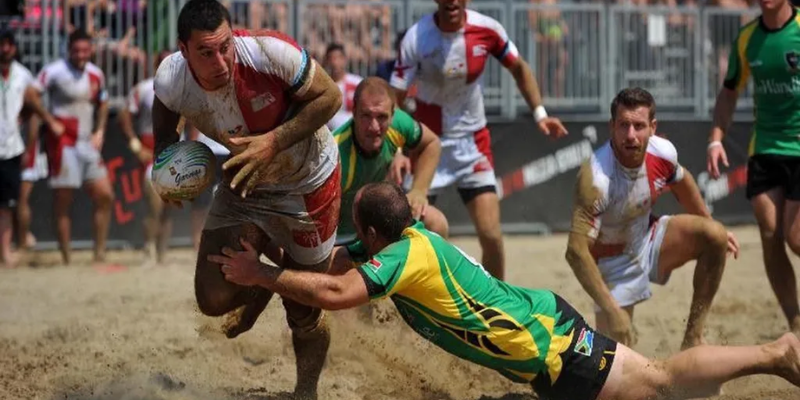Beach rugby is a popular adaptation of traditional rugby union, especially in Italy, the Balkans, and Eastern Europe. Played on sandy beaches, it offers a unique experience for both players and spectators.
In this article, we’ll explore beach rugby rules, gameplay, and major tournaments.
Rules and Gameplay

The beach rugby rules are a simplified version of the rules of traditional rugby, making the game faster and more fun. Here’s a closer look at the beach rugby rules:
- No Set Pieces: Unlike traditional rugby, beach rugby removes rucks, mauls, and scrums, keeping the game flowing without interruptions.
- Low Kicks Only: Players can’t kick the ball above waist height, promoting precise passing and ball-handling skills.
- Smaller Field: Beach rugby fields are compact, requiring quick decision-making and agile movements from players.
- Shallow In-Goals: Scoring is challenging due to shallow in-goals, adding a unique element to the game.
- Small Teams: Teams usually have 4 or 7 players, ensuring everyone plays a significant role.
- Flexible Substitutions: Substitution rules vary, allowing teams to adjust strategies based on game situations.
- Rugby Principles: Despite changes, beach rugby maintains core principles like tackling and sportsmanship.
Sand Rugby Clothing
Here’s a look at the important clothing for beach rugby:
- Jerseys/Tops: Lightweight and breathable jerseys or tops are essential for sand rugby. They should offer moisture-wicking properties to keep players cool and dry in the sun.
- Shorts: Loose-fitting shorts made from quick-drying materials are preferred for rugby beach. They provide freedom of movement and help players stay comfortable during intense matches.
- Footwear: Many beach rugby players play barefoot to enhance grip and agility on the sand. However, some may wear lightweight, flexible shoes or sandals for protection and support.
- Hats/Visors: Wide-brimmed hats or visors offer sun protection for players’ faces and help reduce glare during gameplay.
- Sunglasses: Polarized sunglasses with UV protection are crucial for shielding players’ eyes from the sun’s glare while maintaining clear vision on the beach.
- Sunscreen: Sunscreen is a must-have for beach rugby players to protect exposed skin from harmful UV rays. Players should apply and reapply sunscreen regularly throughout the game.
- Compression Gear (Optional): Some players may wear compression tops or shorts to support muscles and reduce fatigue during matches.
- Accessories: Accessories like sweatbands or wristbands can help absorb sweat and keep players’ hands dry for better grip on the ball.
Overall, beach rugby clothing should prioritize comfort, breathability, and sun protection to ensure an enjoyable and safe playing experience in the sand and sun.
Evolution of the Game
Beach rugby has grown from a casual activity to a structured sport with clear rules and organized tournaments. It’s become popular in beach-focused areas like Italy and Eastern Europe, leading to formal leagues and competitions.
Standard rules, governing bodies, and international tournaments have recognized beach rugby. Efforts to promote the sport globally and attract new players and fans are ongoing.
What is beach rugby❓
Beach rugby is a variant of traditional rugby union played on sandy beaches, offering a dynamic and fast-paced experience for players and spectators alike.
How does beach rugby differ from traditional rugby❓
Beach rugby simplifies the rules, eliminating set pieces like scrums, mauls, and rucks. It also restricts kicks above waist height and features smaller field dimensions.
How many players are typically on a beach rugby team❓
Beach rugby teams usually consist of 4 or 7 players, depending on the specific tournament or league rules.
What are the key rules of beach rugby❓
Some key rules include no rucks, mauls, or scrums, no kicks above waist height, and shallower in-goals. These rules contribute to the fast-paced and fluid nature of the game.
Where did beach rugby originate❓
Beach rugby originated from informal matches played by rugby enthusiasts on beaches worldwide. Over time, it evolved into a structured sport with defined rules and organized tournaments.
Beach Rugby Leagues and Tournaments
Beach rugby is becoming more popular globally, leading to the creation of many leagues and tournaments.
Here are a few more noteworthy events:
World Beach Rugby

This global tournament changes its location each year, featuring top beach rugby players worldwide.
With its exciting format and intense competition, the World Beach Rugby draws teams and spectators from various backgrounds, making it a top sporting event.
Australian Beach Rugby Championships
Australia hosts this tournament on its beautiful coastlines, where teams from across the country compete for victory on the sand.
The Australian Beach Rugby Championships are famous for their fast-paced games and lively atmosphere, attracting participants and fans looking for an exciting rugby experience.
South American Beach Rugby Tour
This tour visits different beaches in South America, like Brazil, Argentina, and Uruguay.
Teams from across the continent gather for tournaments, promoting camaraderie and competition while boosting beach rugby’s popularity in the region.
Asian Beach Rugby Invitational
The Asian Beach Rugby Invitational happens in scenic locations like Thailand, Japan, and the Philippines. Teams from across Asia compete, showcasing their skills.
This tournament emphasizes the popularity of beach rugby globally.
African Beach Rugby Cup
This tournament is Africa’s top beach rugby event, with teams from South Africa, Kenya, and Madagascar competing.
The African Beach Rugby Cup has a lively atmosphere and tough competition, celebrating rugby’s diversity in Africa.
These tournaments and many others contribute to beach rugby’s popularity and growth globally.
Conclusion
In summary, beach rugby has become very popular around the world. It is a simpler version of regular rugby, played on sandy beaches, and is fun to watch.
Some traditional rugby rules have been changed to make sand rugby faster and more exciting.
Basic beach rugby no longer includes complicated things like scrums or high kicks. The teams are smaller, usually 4 or 7 players, and move on a smaller field.
So whether you are a player or a fan, beach rugby offers a different and pleasant way to experience your favourite game.





